Check out these amazing hotel deals!
- Save up to 30% on your hotel in Hawaii!
- Last-minute holiday hotel deals
- Top hotel deals for a new year trip
- Visiting Paris? Find the Best Deals & Reviews at TripAdvisor.
- Save 30% on hotels in Ocean City, Maryland...a TripAdvisor Top 10 Summer Destination!
- Save up to 30% on your hotel on your Winter Vacation!
- Find top-rated hotels at the lowest prices on TripAdvisor. Check rates now!
- Save up to 30% on hotels for a romantic getaway!!
Italy is a true treasure chest full of treasures like landscapes, art, culture, food, and crafts. Among the wonders enclosed in the beautiful country, there are also numerous churches of incredible value and beauty. In this post, we on a “tour” of the 20 most beautiful cathedrals in Italy. But, before that, let’s clarify the difference between a church, basilica, duomo, and a cathedral.
First and foremost, they are all are churches. The basilica is, literally, the house of the king, hence, the Lord (from the Greek basileus = king, and oikos = house). Therefore, each church can be considered a basilica, but it must be important and have an undoubted artistic value. The duomo (from the Latin domus = house) is always the house of God, but it’s the most important church in a city. If the duomo is located in a city that is a bishopric, it takes the name of cathedral, because the bishop has his throne.
NOTE: The following ranking is the result of a survey that involved over 10,000 travelers who were asked to select 5 preferences from a group of over 200 Italian churches.
20. Cathedral of Lecce
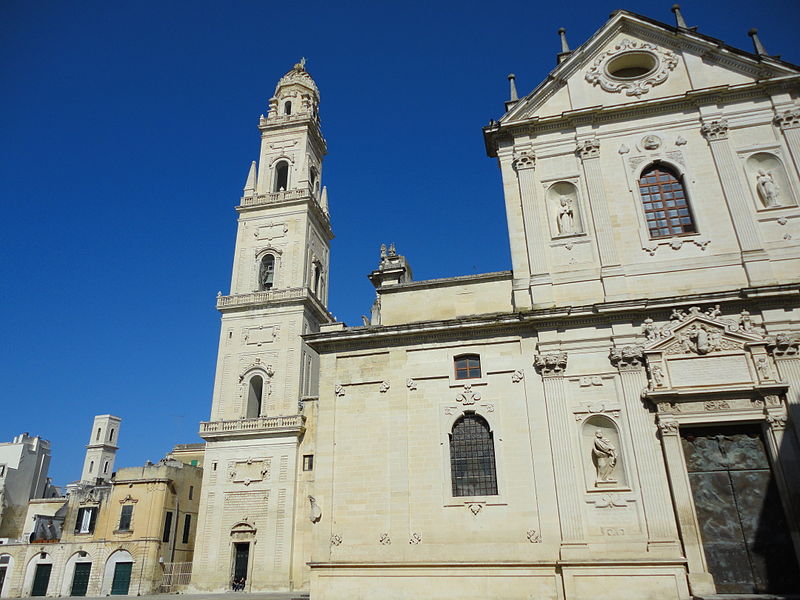
Year: 12th century
Architectural style: Lecce baroque
Fun fact: The bell tower is “new”, as it was built to replace the Norman one, commissioned by Goffredo d’Altavilla and collapsed at the beginning of the 17th century.
The Cathedral houses 12 altars, plus the main one, and is rich in paintings by various artists. The bell tower, 72 meters high, allows you to admire the Adriatic Sea. On particularly clear days, you can even see the mountains of Albania. The tower has a slight curvature to the left due to a slight subsidence of the foundations.
19. Cathedral of Gerace (Calabria)
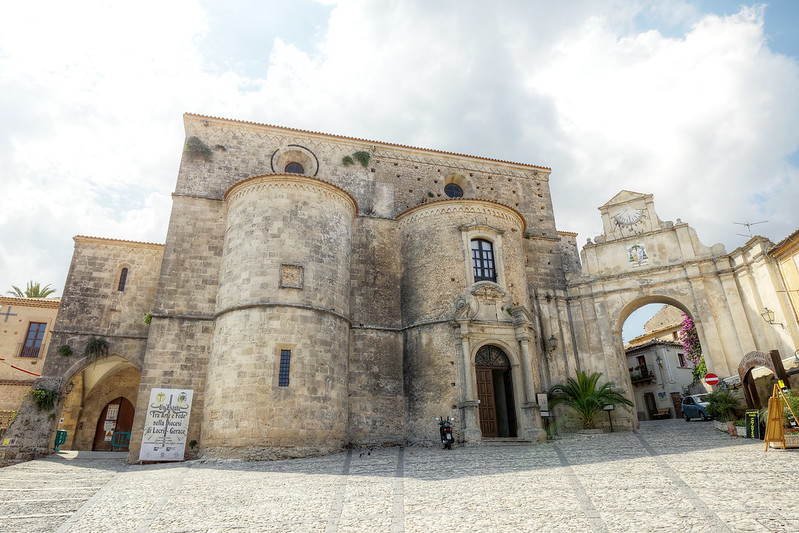
Year: 11th century
Architectural style: Norman-Romanesque-Byzantine
Fun fact: Among the treasures, there is a stauroteca (case of the sacred wood) in gilded silver, semiprecious stones, and beads. It was probably manufactured in Jerusalem or in the Sicilian Norman workshops in the 12th century.
The co-cathedral of Santa Maria Assunta die Gerace is one of the most important Norman buildings in Calabria as well as one of the largest religious buildings in the region. Its history is a succession of damage and collapses, culminating in the earthquake of 1783 and its consequent abandonment. Afterward, careful restoration works were carried out.
Traditionally, the church was consecrated in 1045, but in 1222 there was a second consecration, most likely in the presence of Emperor Frederick II of Swabia, passing through Gerace.
18. Cathedral of Trani (Puglia)
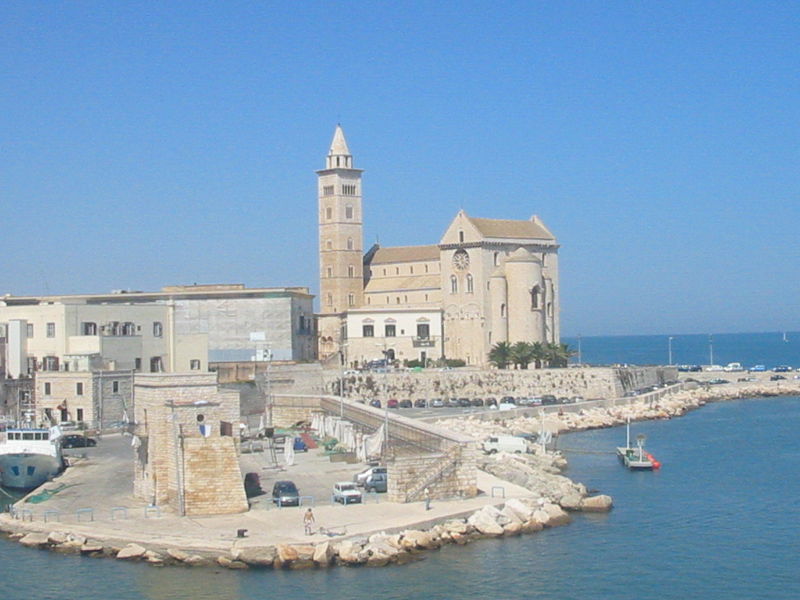
Year: 1099
Architectural style: Romanesque
Fun fact: It was built using Trani stone. It’s a calcareous tuff, extracted from the city quarries, characterized by a very light pink, almost white, color.
A legend has it that Nicola Pellegrino landed in Trani shortly before his death. After his death, several miracles occurred. That’s why he was canonized and his relics placed in the lower part of the church. The cathedral was consecrated before its completion. Regarding the mosaic flooring, inspired by that of the Cathedral of Otranto, there are only a few fragments left in which the allegory of Alexander the Great’s Ascent in flight and the episode of the Original Sin of Adam and Eve can be recognized.
17. Cathedral of Bitonto (Puglia)
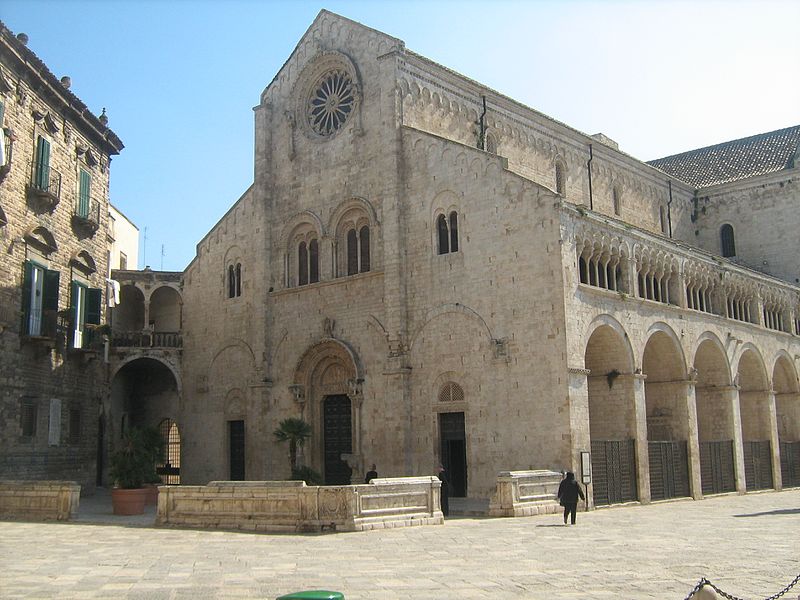
Year: 11th/12th century
Architectural style: Romanesque
Fun fact: It’s considered the most complete and mature expression of the Apulian Romanesque. Its splendid and rick carved portal and rose window, the first in Puglia with an overarch surmounted by a sphinx and flanked by two lions on hanging columns, are of inestimable and artistic value.
Dedicated to Valentine’s Day, it’s located in the center of the city. An elegant, majestic, and haughty place. The magnificent salient facade and the interior full of mosaics and decorations will amaze you.
16. Cathedral of Noto (Sicilia)
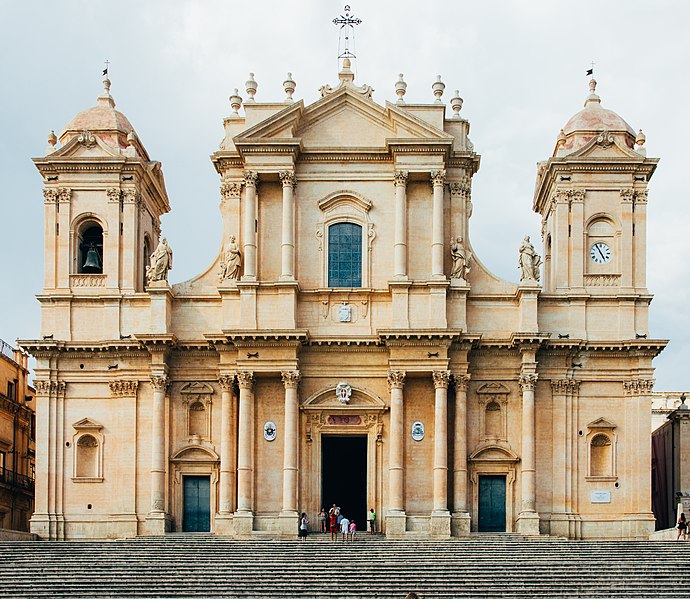
Year: 1694
Architectural style: Sicilian Baroque
Fun fact: It houses numerous artistic works, some of which come from Noto Antica, including the silver urn containing the remains of St. Corrado Confalonieri. After the earthquake of 13 December 1990, the church suffered some structural damage which was followed by the disastrous collapse of 1996 caused by a serious construction defect never detected before. This makes it one of the last major sites of contemporary sacred art.
It’s dedicated to San Nicolo and houses exceptional works, including contemporary ones. Furthermore, Noto is a suggestive city, so you can just let yourself to be enchanted.
15. Cathedral of Otranto (Puglia)
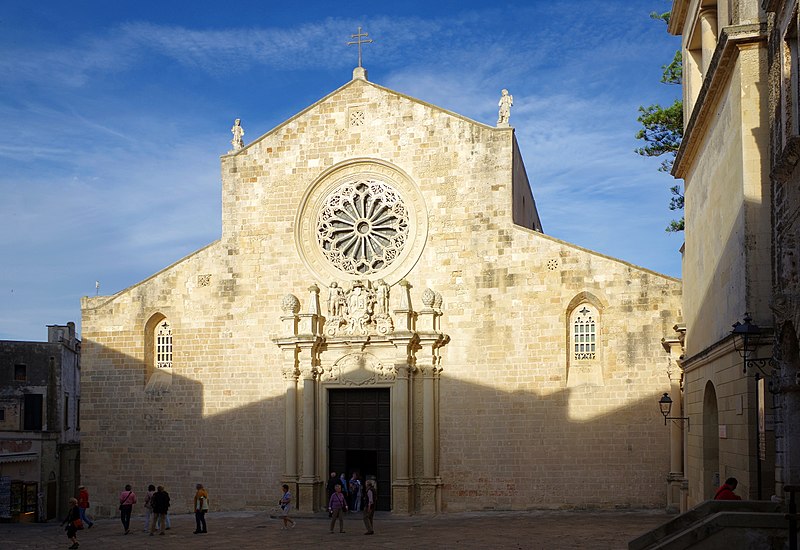
Year: 1068
Architectural style: Romanesque
Fun fact: It was built on the remains of a Messapian village, a Roman domus, and an early Christian temple.
In 1480, the Turks managed to conquer the city and enter the church, exterminating the clergy and civilians who had taken refuge there. Then, it was transformed into a mosque and all the 13th-century frescoes were destroyed. In 1481, after the liberation of Otranto thanks to Alfonso V of Aragona, the church was heavily remodeled.
The large floor mosaic is of great scenic impact as well as an unusuality of the cathedral. On it, scenes from the Old Testament, chivalrous cycles, bestiaries, and Alexander’s Romance are represented. The images unfold along the Tree of Life, retracing the human experience, from the original sin to salvation. Among the images, there is also the ascension of Alexander the Great on an aircraft towed in the sky by two griffins (allegory of pride, very present in the Christian Middle Ages).
14. Basilica of Saint Anthony, Padua (Veneto)
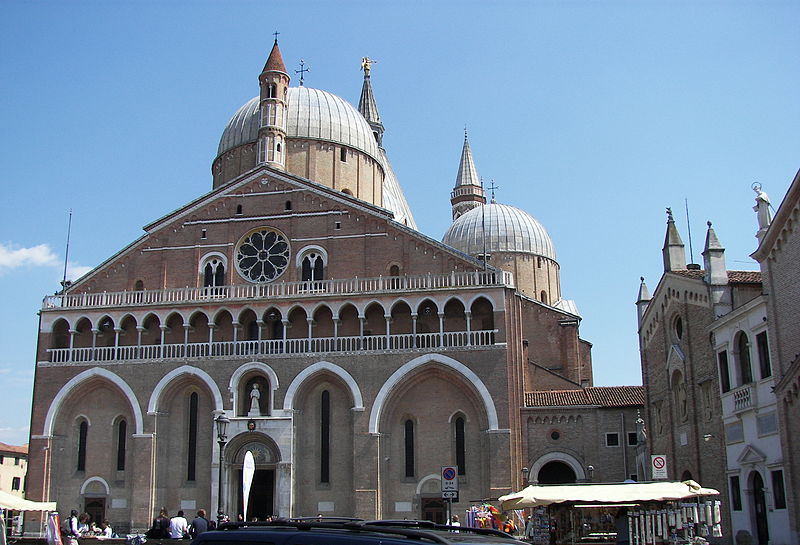
Year: 1232
Architectural style: Romanesque, Gothic, Byzantine, Renaissance, Baroque
Fun fact: Known by the Paduans simply as “the Saint”, it’s one of the largest churches in the world. More than 6.5 million pilgrims go there every year. This is why it’s one of the most revered sanctuaries in the Christian world. This basilica houses the relics of Saint Anthony of Padua and his tomb.
It’s characterized by a perfect harmony of different styles: the Romanesque gabled facade, the buttresses that develop to become Gothic-style flying buttresses, the Byzantine-style domes, and the two twin bell towers that almost recall minarets. Furthermore, in front of the basilica, in the square, there is the equestrian monument to Gattamelata, made by Donatello. Lots of high-level art enclosed in a small space!
13. Cathedral of Saint Zeno, Pistoia (Tuscany)
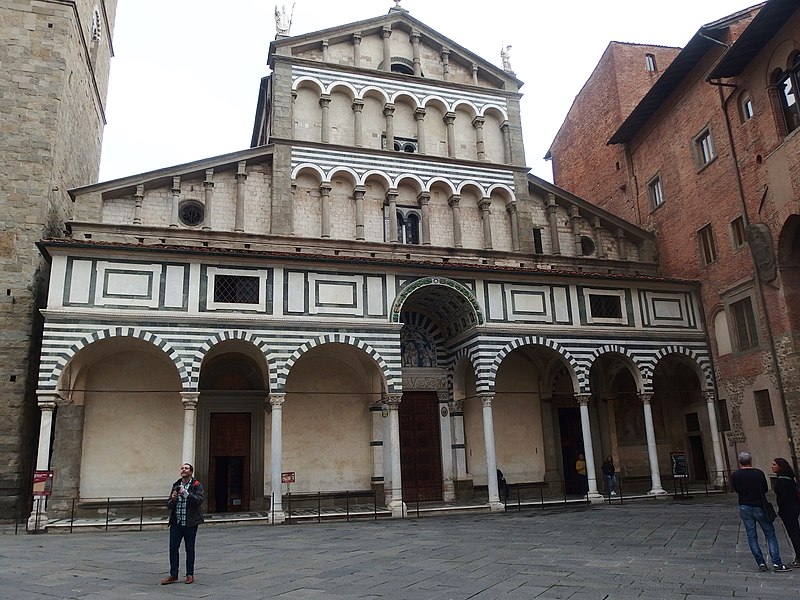
Year: 10th century
Architectural style: Romanesque, Baroque
Fun fact: According to a legend, the cathedral was initially dedicated to San Martino, Under the Lombard domination, it was dedicated to Saint Zeno.
It’s a church full of artistic treasures. The right aisle was originally occupied by the Chapel of San Jacopo, built by Bishop Atto to deposit the relic of San Giacomo brought from Santiago de Compostela. Originally the chapel, which no longer exists today, housed the silver altar which today resides in the Chapel of the Crucifix.
12. Cathedral of Saint Lorence, Genoa (Liguria)
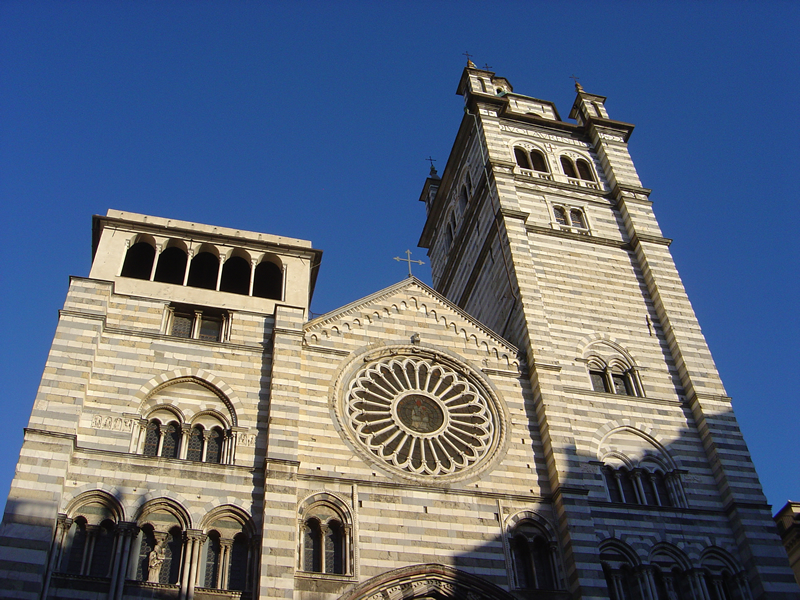
Year: 1098
Architectural style: Romanesque and Gothic
Fun fact: It was consecrated to the saint in 1118 when it wasn’t yet completed and the facade was missing.
It is a very rich and beautiful church. The facade has splendid Gothic portals: French workers were called to build them. Above, it has a characteristic black and white banded vestment, a symbol of nobility in the Middle Ages. The initial project included two bell towers. The left tower was never finished, which is why only the lower trunk was built. On it, a loggia was superimposed in 1477.
11. Basilica of Superga, Torino (Piedmont)
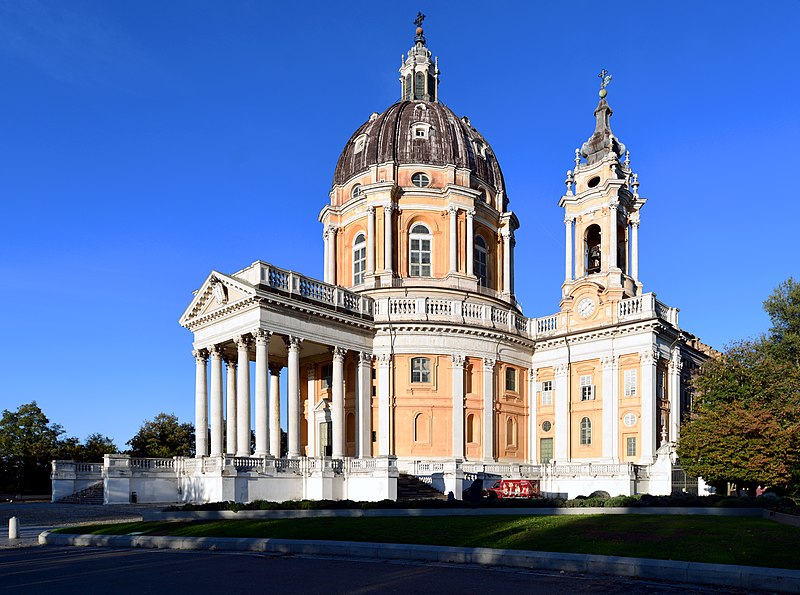
Year: 1717
Architectural style: late baroque, neoclassical
Fun fact: How many will recall that this church is related to a tragic human and sporting event? On May 4, 1949, the plane carrying the Grande Torino football team, returning from Lisbon, crashed into the back of the complex. Unfortunately, they all died and, in their honor, there’s a small commemorative area with a plaque, which is a pilgrimage destination for sportsmen and women alike.
It was built by King Vittorio Amedo II as gratefulness to Virgin Mary after defeating the French who besieged Turin in 1706. By the will of Vittorio Amedeo III, some members of the House of Savoy were buried there. It’s an interesting and very impressive complex.
10. Cathedral of Syracuse (Sicily)
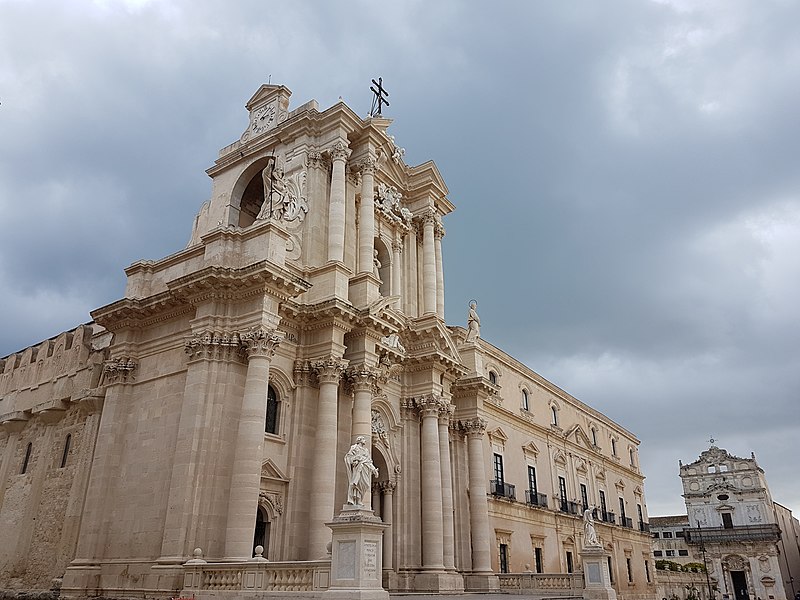
Year: 7th century
Architectural style: Baroque
Fun fact: It rises on the elevated part of the island of Ortigia and incorporates what was the most important Doric-style sacred temple of the Syracusan polis, dedicated to Athena. Then, it was converted to a church with the advent of Christianity and dedicated to the Nativity of Mary the Holiest.
Considered the most important church in Syracuse, it’s a UNESCO World Heritage Site. It houses statues, relics, and remains of saints, martyrs, and Syracusan nobles. It is a building of undoubted artistic value.
9. Cathedral of Matera (Basilicata)
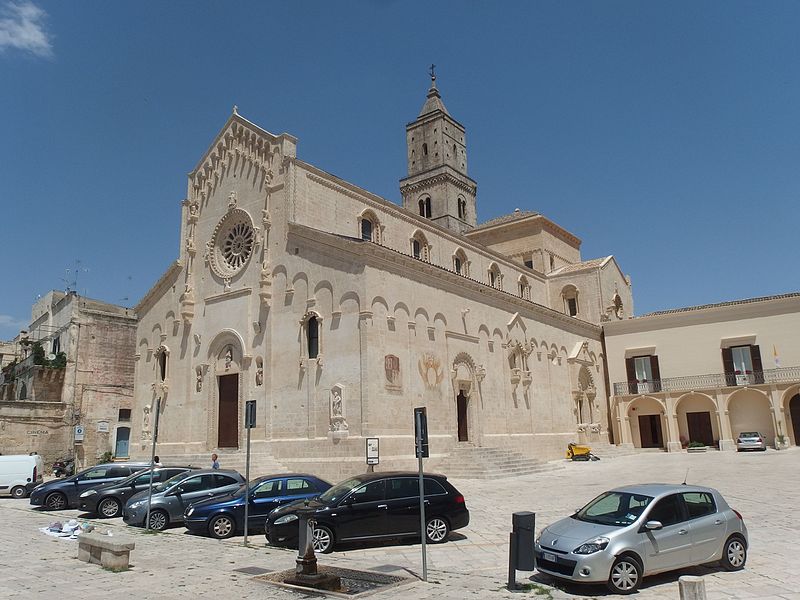
Year: 1230
Architectural style: Apulian Romanesque and Baroque
Fun fact: It was built on the highest spur of the Civita that divides the two Sassi, the historic center of the city. They are a UNESCO World Heritage Site and were the first site in southern Italy to be inscribed on the list.
Unlike the interior, which has undergone several transformations over time, the exterior retains its original shape almost intact. The facade is dominated by a rose window with 16 rays, surmounted by the Archangel Michael. In the apse, there is a wooden choir in solid walnut or enormous value divided into 60 stalls. Above, to the right of the presbytery, there is a monumental organ with over 3000 pipes.
8. Amalfi Cathedral (Campania)
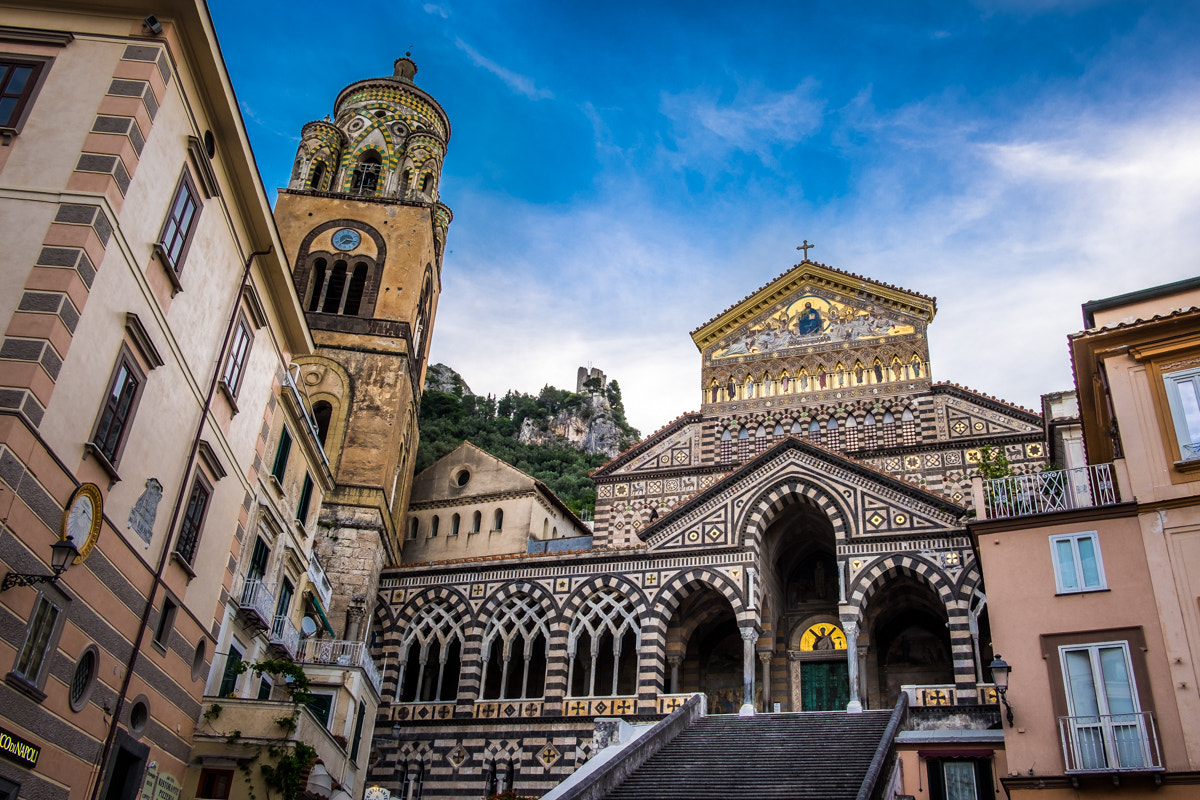
Year: 987
Architectural style: Romanesque, Baroque, Rococo, Neo-Moorish
Fun fact: Originally, there were two basilicas in Amalfi and both have three naves. The basilica was transformed in the first decades of the 13th century by joining the two places of worship into one with only five naves.
From the left side of the portico, you enter the Cloister of Paradise: a real corner of the East in the south of Italy. It consists of a four-sided portico with intertwined pointed arches, typical of Arab-Norman art, supported by very fine columns. It was built between 1266 and 1268 as a cemetery for illustrious Amalfi citizens. After having almost fallen into neglect in the 17th century, it was restored in 1908 and later opened to the public.
7. Cathedral of Palermo (Sicily)
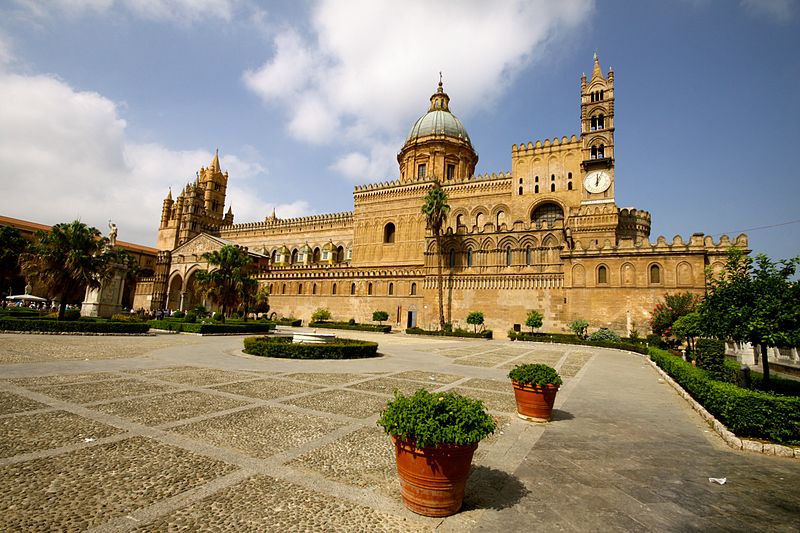
Year: 1185
Architectural style: Norman Romanesque, Gothic, Baroque, Neoclassical
Fun fact: It has a sundial on the floor. It’s a long brass strip set in marble. Cross the central nave flanked by polychrome inlays depicting the zodiac signs.
A UNESCO heritage, the cathedral is dedicated to the Assumption of the Virgin. The Madonna is represented in three different iconographies: the Dormition of the Mother of God which belongs to the Byzantine tradition, the Assumption and the Coronation in Heaven which belongs to Latin tradition, and the “Madonna della Luce” (The Mother of God of Light), known in Sicily as Madonna del Lume (probably derived from the Byzantine Virgin Odighitria). It’s the one who shows the way, the direction. In Sicilian tradition, it can be traced back to the Madonna protector of sea travel, ports, and lighthouses.
6. Basilica of Saint Francis, Assisi (Umbria)
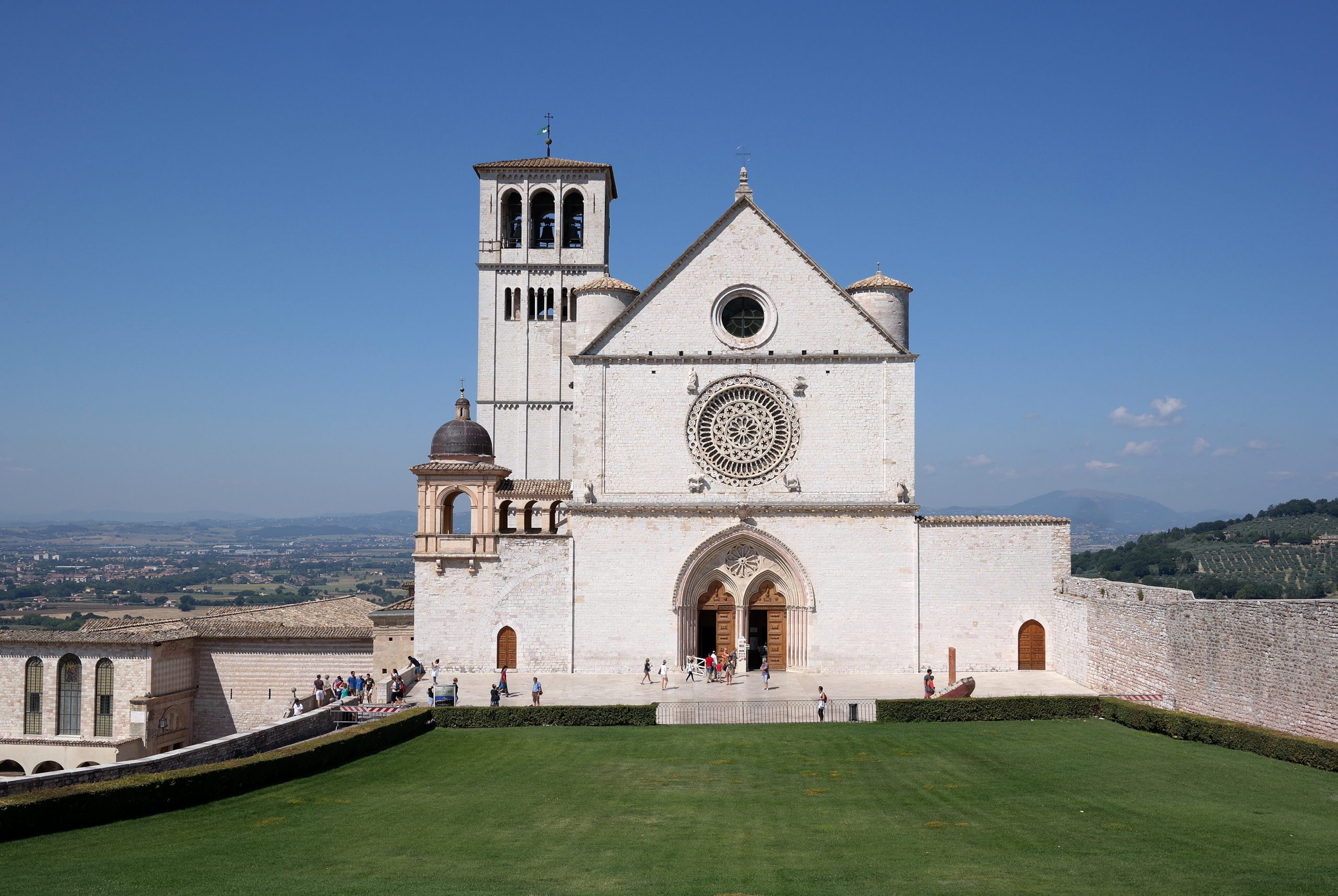
Year: 1228
Architectural style: Italian gothic
Fun fact: It’s the place that since 1230 preserves and guards the remains of the patron saint of Italy as well as one of the most loved.
A stupendous basilica and not surprisingly a UNESCO World Heritage Site. It is said that Francis himself indicated the place where he wanted to be buried. The lower hill of the city was used to bury the “lawless”, i.e. those condemned by justice. Although Francis’ testamentary dispositions recommended the construction of churches according to the first rule of his order, that is poverty, the basilica was an exception. It was possible only because the beautiful structures of the church were intended as a means of transmitting the Franciscan message, especially through the figurative decorations that were to create a so-called Biblia pauperum, or “Bible for the poor”. In fact, the illiterate, unable to read, were still able to understand through images.
5. Cathedral of Saint Mary of the Flower, Florence (Tuscany)
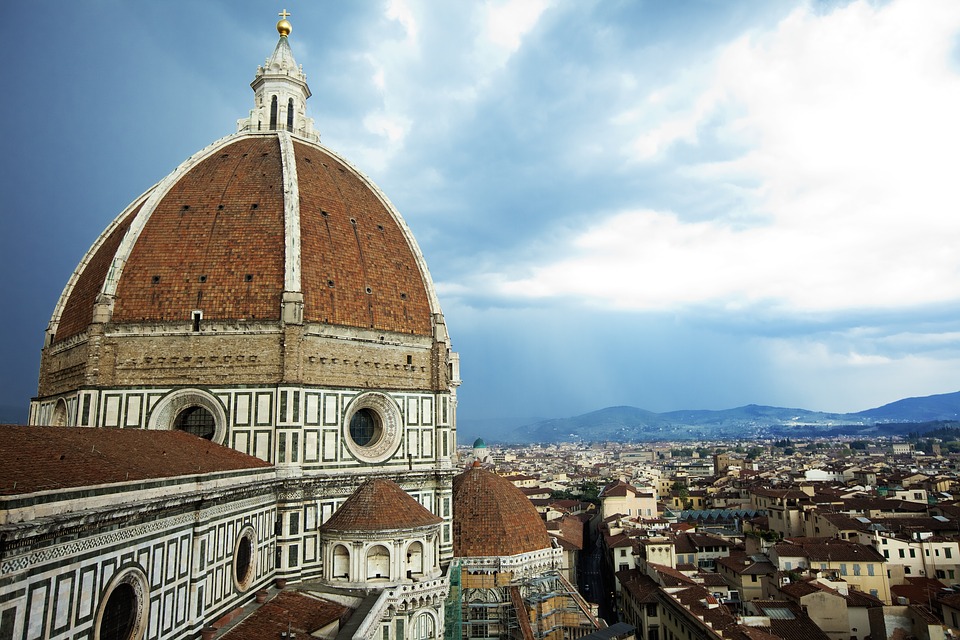
Year: 1296
Architectural style: Gothic, Renaissance, Neo-Gothic
Fun fact: Brunelleschi’s dome also houses an astronomical instrument for studying the sun: a gnomonic hole that provides a projection of the star on the shadowed surface of the cathedral floor.
Famous, both, for the splendid dome by Brunelleschi and for its undeniable beauty, this cathedral is one of the many jewels of the city of art par excellence. Saint Mary of the Flower (Santa Maria del Fiore) is striking for its size and for its appearance as a unitary monument, especially on the outside, due to the continuous use of the same materials: white marble from Carrara, green from Prato, red from Maremma, and terracotta tiles. In reality, each part reveals considerable stylistic differences due to the very long period of time execution. The interior, rather simple and austere, creates a strong feeling of “emptiness”. Some works reflect the public function of the building, with monuments dedicated to illustrious citizens and Florentine military commanders.
4. St. Peter’s Basilica, Vatican City – Rome (Vatican State – Lazio)
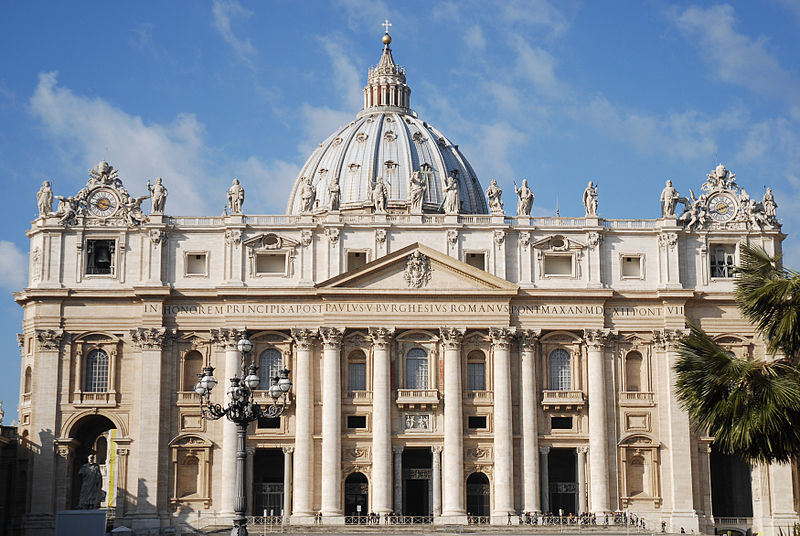
Year: 1506
Architectural style: Renaissance and Baroque
Fun fact: It’s not the cathedral church of the diocese of Rome (that’s the basilica of San Giovanni in Laterano). However, it’s the Mother Church and Head of all the Churches of the City and of the World.
A church that definitely needs no introduction. A monumental work in which important artists of immense fame took part. St. Peter’s Basilica is one of the largest buildings in the world and can hold up to 60,000 believers. The building is entirely accessible along its perimeter, although connected to the Vatican Palaces by an elevated corridor and the Scala Regia. Along the aisles, at the 45 altars and in the 11 chapels, various masterpieces of inestimable historical and artistic value are housed. The best-known among them are the Pieta and the brilliant dome by Michelangelo, the prestigious Baldacchino di San Pietro, and the papal altar by Bernini.
3. Saint Mark’s Basilica, Venice (Veneto)
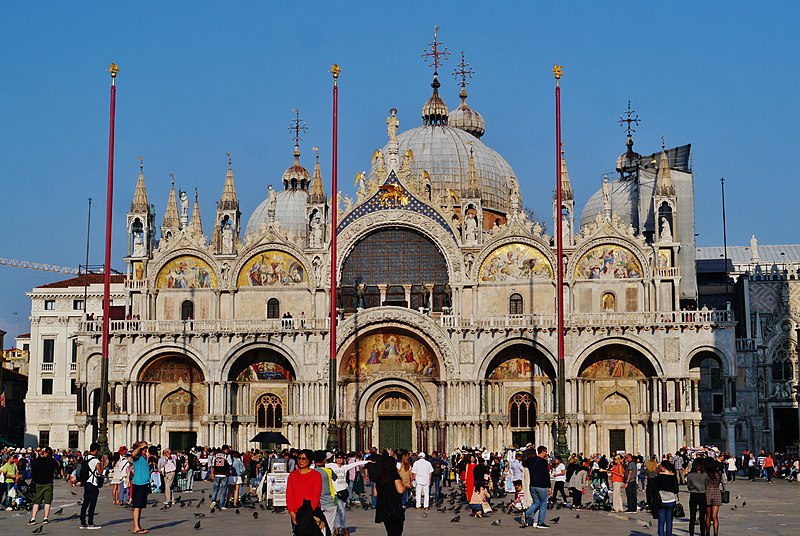
Year: 1063
Architectural style: Romanesque-Byzantine and Gothic
Fun fact: THe quadriga with horses, above the central portal of the basilica, was very similar to those that adorned numerous triumphal arches in antiquity. However, this is the only example left in the world. After the long restoration, the horses of Saint Mark are now preserved in the museum inside the basilica. Those on the outside are a copy.
It’s one of the symbols of Venice as well as Italy. The splendid golden mosaic decoration of the interior is a real spectacle enviable by the world. It’s also very rich in columns, friezes, marbles, sculptures, and gold brought to Venice by merchants thanks to their ships that trafficked with the East. Often, it was bare material, a material obtained from ancient demolished buildings. The spoils of the sack of Constantinopole, on the other hand, which took place during the Fourth Crusade, enriched the treasury of the basilica and provided it with furnishings of great prestige. Among the artworks from Constantinopole, the most famous is the one depicting the bronze horses gilded and silvered, placed above the central portal.
2. Milan Cathedral (Lombardy)
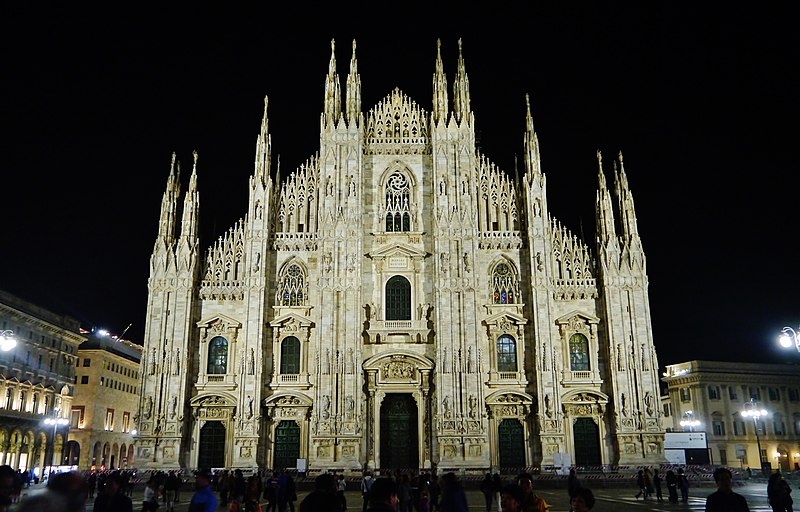
Year: 1386
Architectural style: Gothic, Neoclassical, Neo-Gothic
Fun fact: During the Second World War the Madonnina was covered with rags to prevent the reflections of light on its golden surface from being a reference point for bombers. The windows, on the other hand, were previously removed and replaced by rolls of canvas.
It is definitely a church that needs no introduction. It’s the indisputable symbol of Milan with its famous and soaring Madonnina. The distinctive feature of the Duomo, apart from its shape, is the extraordinary abundance of sculptures present everywhere and its spectacular stained glass windows. In November, the period dedicated to San Carlo Borromeo, the so-called “Quadroni di San Carlo” are exhibited. They are a cycle of 56 large canvases celebrating the life and miracles of the well-known archbishop of Milan. They are the most important pictorial cycle of the Lombard Baroque. Suspended above the main altar, there is the most precious relic of the Cathedral: the nail of the True Cross, also known as the Sacred Nail.
According to a legend, it was found by Saint Helena and used as a bit of the horse of Constantine I horse. Although suspended very high, red light makes it visible from all over the cathedral. The nail is shown to the believers every May 3. The 17th-century “nivola”, an interesting lift now mechanized, is used to take it out of its custody. But the Cathedral is so rich in treasures that a brief description is impossible. If you want to see all of them, it’s best to discover them for yourself… you will be charmed!
1. Siena Cathedral (Tuscany)
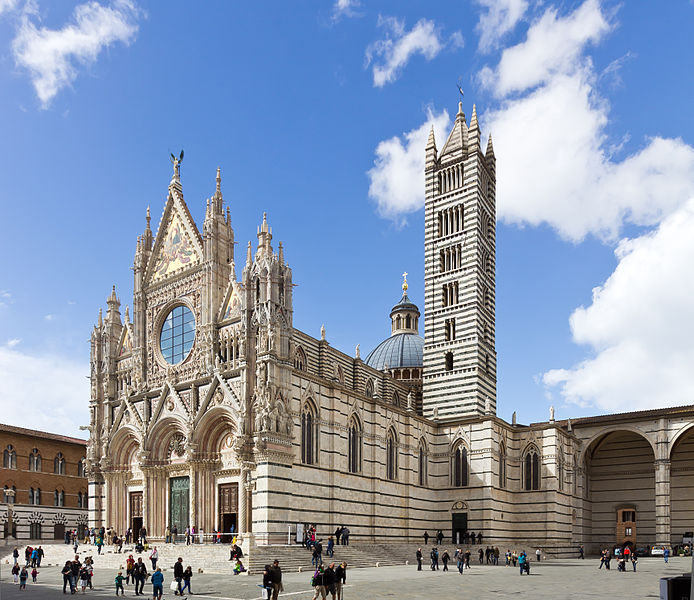
Year: about 1220
Architectural style: Romanesque and Italian Gothic
Fun fact: The church is closely linked to the Palio di Siena. After the end of the August Palio, the victorious contradaioli go to the Duomo with the Drappellone, to sing the Te Deum of thanksgiving to the Assumption of Mary. The Drappellone, called the “rag” by the Sienese, represents the trophy to be delivered to the Contrada that won the Palio di Siena on 2 July and 16 August.
It is a very rich church of inestimable artistic and cultural value. An incredible work! Built in the Italian Roman-Gothic style, it’s one of the most significant cathedrals made in this style in Italy. The whole internal structure is dominated by the two-tone black and white, referring to the colors of the Siena coat of arms. A sophisticated light-dark effect was also created. Also, the floor is nothing short of spectacular! It’s a unique work in Italian art, for the richness, creativity, vastness, and importance of the names that have worked on it. Divided into 56 squares, it was continuously restored to prevent wear. A church that will leave you amazed and speechless, a true jewel of Italian art and a rare pearl in the artistic world.
Check out these amazing hotel deals!
- Save up to 30% on your hotel in Hawaii!
- Last-minute holiday hotel deals
- Top hotel deals for a new year trip
- Visiting Paris? Find the Best Deals & Reviews at TripAdvisor.
- Save 30% on hotels in Ocean City, Maryland...a TripAdvisor Top 10 Summer Destination!
- Save up to 30% on your hotel on your Winter Vacation!
- Find top-rated hotels at the lowest prices on TripAdvisor. Check rates now!
- Save up to 30% on hotels for a romantic getaway!!
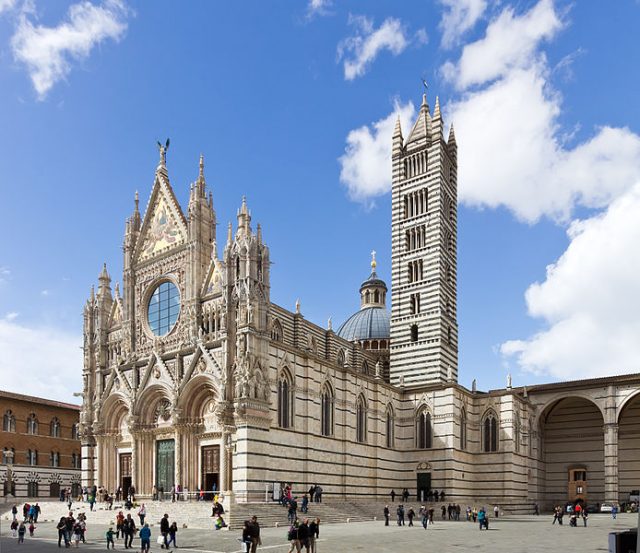
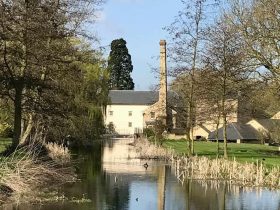




Find Us on Socials